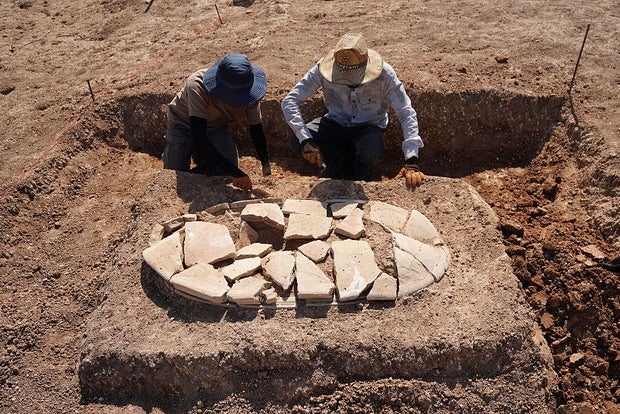Archaeologists in drought-hit Iraq have found 40 historical tombs after water ranges within the nation’s largest reservoir declined, an antiquities official mentioned Saturday.
The tombs, believed to be over 2,300 years previous, have been unearthed on the edges of the Mosul Dam reservoir within the Khanke area of Duhok province within the nation’s north.
“Thus far, we now have found roughly 40 tombs,” mentioned Bekas Brefkany, the director of antiquities in Duhok, who’s main the archaeological work on the website.
ISMAEL ADNAN/AFP by way of Getty Photos
His staff surveyed the realm in 2023 however solely noticed elements of some tombs.
They have been solely in a position to work on the location when water ranges dropped “to their lowest” this yr, Brefkany mentioned.
In recent times, archaeologists have uncovered ruins courting again 1000’s of years in the identical space, on account of droughts which have plagued Iraq for 5 consecutive years.
“The droughts have important influence on many features, like agriculture and electrical energy. However, for us archaeologists… it permits us to do excavation work,” Brefkany mentioned.
The newly found tombs are believed to this point again to the Hellenistic or Hellenistic-Seleucid interval, in line with Brefkany.
ISMAEL ADNAN/AFP by way of Getty Photos
He added that his staff is working to excavate the tombs to switch them to the Duhok Museum for additional examine and preservation, earlier than the realm is submerged once more.
Iraq, which is especially susceptible to the results of local weather change, has been going through rising temperatures, continual water shortages and year-on-year droughts.
Authorities have warned that this yr has been one of many driest since 1933 and that water reserves have been all the way down to solely eight p.c of their full capability.
In addition they blame upstream dams in-built neighbouring Iran and Turkey for dramatically decreasing the stream of the once-mighty Tigris and Euphrates, which have irrigated Iraq for millennia.
Earlier this year, archaeologists in Egypt unveiled the millennia-old tombs of three senior statesmen, recognized by inscriptions left on the tombs. The three websites within the metropolis of Luxor date to the New Kingdom period, Egypt’s Ministry of Tourism and Antiquities said on social media, which ranged from about 1550 to 1070 B.C.
This is premium stuff. Subscribe to read the entire article.
Support Greater and Subscribe to view content
















